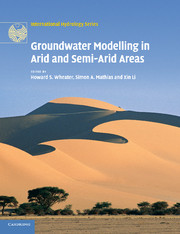Book contents
- Frontmatter
- Contents
- Contributors
- Preface
- Acknowledgements
- 1 Groundwater modelling in arid and semi-arid areas: an introduction
- 2 Hydrological processes, groundwater recharge and surface-water/groundwater interactions in arid and semi-arid areas
- 3 Conceptual models for recharge sequences in arid and semi-arid regions using isotopic and geochemical methods
- 4 Groundwater flow and transport
- 5 Performing unbiased groundwater modelling: application of the theory of regionalised variables
- 6 Groundwater vulnerability and protection
- 7 Variable density groundwater flow: from modelling to applications
- 8 Sustainable water management in arid and semi-arid regions
- Index
- Plate section
- References
7 - Variable density groundwater flow: from modelling to applications
Published online by Cambridge University Press: 06 December 2010
- Frontmatter
- Contents
- Contributors
- Preface
- Acknowledgements
- 1 Groundwater modelling in arid and semi-arid areas: an introduction
- 2 Hydrological processes, groundwater recharge and surface-water/groundwater interactions in arid and semi-arid areas
- 3 Conceptual models for recharge sequences in arid and semi-arid regions using isotopic and geochemical methods
- 4 Groundwater flow and transport
- 5 Performing unbiased groundwater modelling: application of the theory of regionalised variables
- 6 Groundwater vulnerability and protection
- 7 Variable density groundwater flow: from modelling to applications
- 8 Sustainable water management in arid and semi-arid regions
- Index
- Plate section
- References
Summary
INTRODUCTION
Arid and semi-arid climates are mainly characterised as those areas where precipitation is less (and often considerably less) than potential evapotranspiration. These climate regions are ideal environments for salt to accumulate in natural soil and groundwater settings since evaporation and transpiration essentially remove freshwater from the system, leaving residual salts behind. Similarly, the characteristically low precipitation rates reduce the potential for salt to be diluted by rainfall. Thus arid and semi-arid regions make ideal ‘salt concentrator’ hydrologic environments. Indeed, salt flats, playas, sabkhas and saline lakes, for example, are ubiquitous features of arid and semi-arid regions throughout the world (Yechieli and Wood,2002). In such settings, variable density flow phenomena are expected to be important, especially where hypersaline brines overlie less dense groundwater at depth. In contrast, seawater intrusion in coastal aquifers is a global phenomenon that is not constrained to only arid and semi-arid regions of the globe and is inherently a variable density flow problem by its very nature. These two examples make it clear that variable density flow problems occur in, but importantly extend beyond, arid and semi-arid regions of the globe. The intention of this chapter is therefore not to limit ourselves to modelling arid zone hydrological systems, but rather to present a more general treatment of variable density groundwater flow and solute transport phenomena and modelling. The concepts presented in this chapter are therefore not climatologically constrained to arid or semi-arid zones of the world, although they do apply equally there.
Information
- Type
- Chapter
- Information
- Groundwater Modelling in Arid and Semi-Arid Areas , pp. 87 - 118Publisher: Cambridge University PressPrint publication year: 2010
References
Accessibility standard: Unknown
Why this information is here
This section outlines the accessibility features of this content - including support for screen readers, full keyboard navigation and high-contrast display options. This may not be relevant for you.Accessibility Information
- 16
- Cited by
